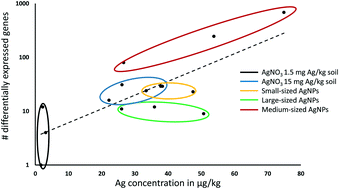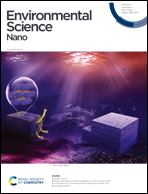Surface coating and particle size are main factors explaining the transcriptome-wide responses of the earthworm Lumbricus rubellus to silver nanoparticles†
Abstract
Due to the unique properties of differently sized and coated silver nanoparticles (AgNPs), they are used in important industrial and biomedical applications. However, their environmental fate in soil ecosystems and potential mechanisms of toxicity remain elusive, especially at the level of transcriptional regulation. We investigated the transcriptome-wide responses of the earthworm Lumbricus rubellus exposed to nine AgNPs differing in surface coating/charge (bovine serum albumin/negative AgNP_BSA, chitosan/positive AgNP_Chit, and polyvinylpyrrolidone/neutral AgNP_PVP) and sizes (20, 35 and 50 nm) at concentrations close to the EC50 value related to reproduction. AgNO3 was used in two concentrations to benchmark the AgNP effects against those of the Ag salt. A correlation was observed between the number of differentially expressed genes (DEGs) and Ag internal body concentration. Only metallothionein was regulated by all treatments. Medium sized AgNPs caused the most pronounced transcriptional responses, while AgNO3 affected the transcriptome less. Medium sized AgNP_BSA exposure caused the most extensive transcriptional responses with 684 DEGs. Gene ontology enrichment analysis of medium sized AgNP_BSA affected DEGs revealed that mitochondrial electron transport, autophagy and phagocytosis, mesoderm and heart development and microtubule organisation were affected. This was also confirmed by gene set enrichment for KEGG pathway analysis, indicating that phagocytosis, autophagy and signalling pathways related to mesoderm formation were significantly up regulated. All AgNP_BSA and AgNP_PVP exposures caused severe down regulation of ribosomal translation, suggesting that the high energy-demanding protein synthesis process is inhibited. Our data confirm the mechanisms previously identified among other animal models and human cell lines. To conclude, coating formulation and particle size severely impact transcriptional responses at a particular nanoparticle size, suggesting diverse mechanistic responses depending on the coating type.



 Please wait while we load your content...
Please wait while we load your content...